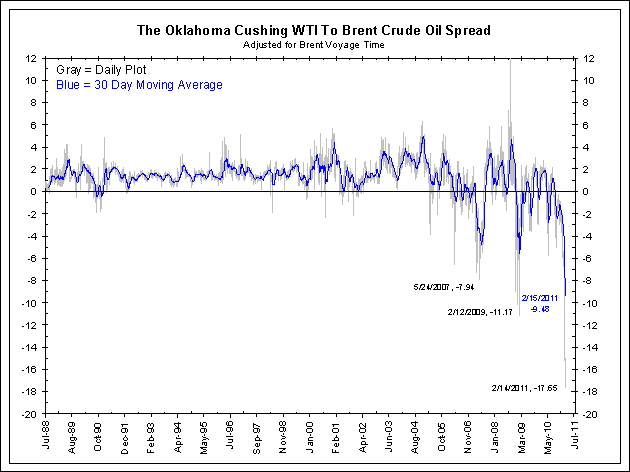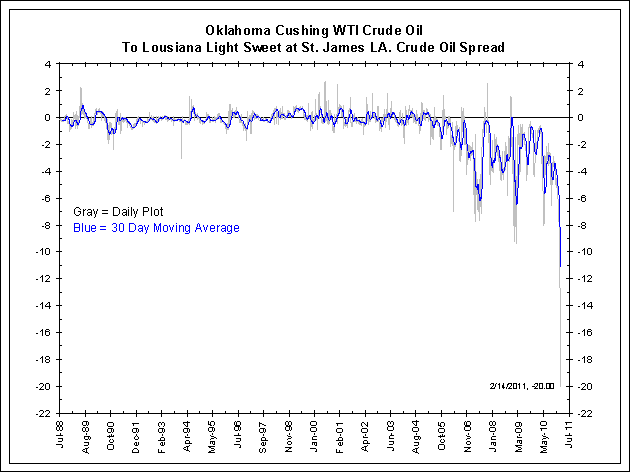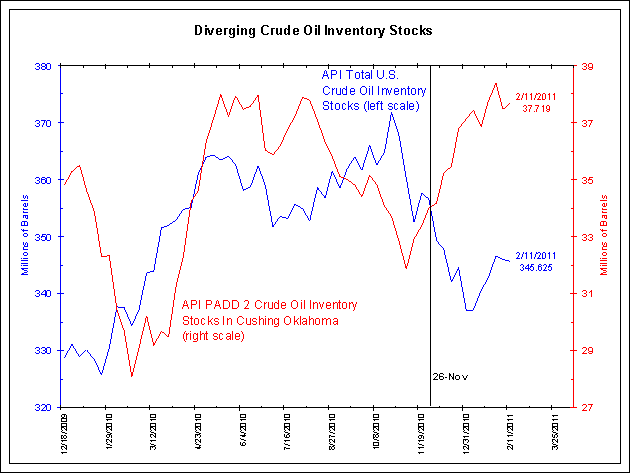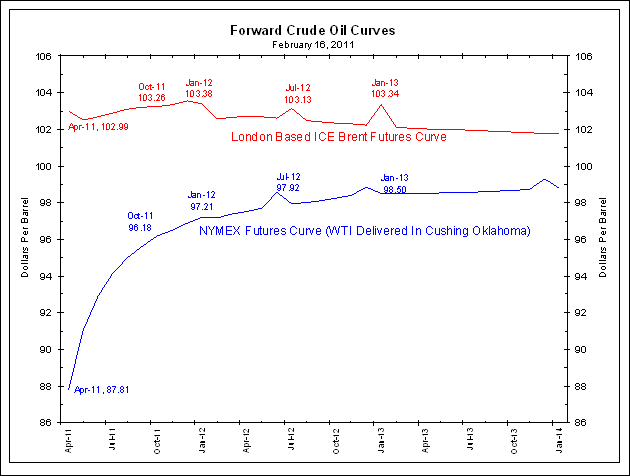Last week, in a post titled Why Crude Oil Prices Are Now Above $100/Barrel, we said:
Events are causing NYMEX futures contracts that are delivered in Cushing Oklahoma to be very unrepresentative of world crude oil prices. Cushing Oklahoma is a landlocked crude oil market served by pipelines. The new Keystone XL pipeline from Alberta Canada is coming online and causing a glut. As a consequence, Cushing delivered crude oil is trading as much as $14/barrel (16%) below other world benchmark crude oil prices. Speculators, engineers and refineries are rushing to take advantage of this situation.
Until the Cushing glut subsides, we must look at other world benchmarks like Brent to get a better gauge of world crude oil prices. When we do, we find energy prices look a lot like food prices as they have been rising smartly over the past few months and most measures are over $100/barrel. They are not trending sideways just under $90/barrel as the NYMEX futures market suggests.
Since we wrote this, the divergence between Cushing and most other crude benchmarks has widened, so an update is in order.
The first chart below shows the prices of various grades of “sweet” (or low sulfur) crude oil. Prices of West Texas Intermediate (WTI) for delivery via pipeline to Cushing Oklahoma and Midland Texas continue to diverge widely from prices of the waterborne (tanker) cargoes originating out of the Bonny oil terminal in Southern Nigeria (Bonny Light in red), the North Sea cargoes from the Sullom Voe oil terminal in Shetland Islands, Scotland (Brent 40s in blue) and St. James Parish in Louisiana that connects to the Louisiana Offshore Oil Port or LOOP (LA Light in Cyan).
<Click on chart for larger image>
What makes the divergence in the chart above so remarkable is the mid-continent pipeline markets are in a clear downtrend while the waterborne tanker markets are in a clear uptrend. As a result, the spread between these markets has widened to levels thought impossible just a few months ago.
As the chart below shows, prior to a few years ago WTI delivered in Cushing would usually trade slightly higher than Brent crude oil. This reflected the premium for Cushing as a pipeline-delivered crude oil, making it cheaper than a tanker-delivered cargo like Brent crude oil. But in recent years supply considerations have made this relationship unstable to the point that spot WTI prices are now trading a record $17.65 (18%) below spot Brent prices.
<Click on chart for larger image>
This is not merely a geopolitical issue brought on by the situation in Egypt. The chart below shows tanker-delivered crude oil in Louisiana versus pipeline-delivered crude oil in Oklahoma. The crude delivered to these two points in the United States that are only a few hundred miles apart have a difference in price of $20 (21%), larger than the WTI/Brent spread. This cannot be the result of unrest in Egypt.
<Click on chart for larger image>
The chart above is simply amazing. The price of crude oil between two delivery points in the United states varies by more than 20%. Did the spread ever get this wide in 1911 when crude oil was delivered in whiskey barrels via mule?
Pipeline Glut
As we detailed last week, increasing inventories into Cushing, Oklahoma are creating a supply glut in the mid-continent markets. As the following chart shows, this is resulting in diverging supplies in Cushing versus the rest of the country. The red line shows crude oil stocks in Cushing, Oklahoma have been going straight up since November 26. The blue line shows crude oil stocks in the entire country have been falling over the same period. The first chart above of benchmark crude prices also highlights November 26. Notice how WTI Midland and Cushing prices started to diverge from other world benchmark prices when inventories started to boom in Cushing.
<Click on chart for larger image>
How Does This Get Resolved?
The next chart shows the forward curves for NYMEX Cushing-delivered crude oil futures (blue) and ICE Brent futures (red). These two forward curves are very different.
NYMEX traders expect the price of Cushing-delivered crude oil to rise to around $97/barrel in six months (September) and approach $100/barrel by the summer of 2012. ICE Brent traders, on the other hand, expect prices to hold steady around $102/barrel through the end of 2013.
So, where do prices even out? The forward futures markets expect Cushing to rise to $100/barrel and align with Brent as the Cushing glut subsides.
This steep forward NYMEX curve, known as contango, also provides an incentive for speculators to buy and store crude now while selling deferred contracts, like September or December, to make delivery against. And indeed this is now happening in a big way.
<Click on chart for larger image>





